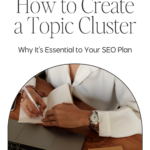
Topic Clusters: Why It’s Essential to Your SEO Plan
Table of Contents
ToggleSharing is caring!
Reading Time: 5 minutes


When blogging about a primary topic, you can't simply lump together all the information in a 45-page-long blog post without making your audience lose interest. It's necessary to break down the subtopics into shorter blog posts to support the main topic.
Imagine your blog as a series of interconnected ideas, and each topic is a puzzle piece that fits with others. That's what a topic cluster is; it covers a specific topic with related subtopics to create in-depth resources readers can access. The idea behind topic clusters is to give readers a well-rounded, engaging experience.
Your main topics are the central theme to blog about; they're the hub of the cluster. Because the main topics are quite broad, you must highlight various angles to cover everything about the general topic.
For example, if your topic is “Online Marketing,” the central theme would be digital promotion. This broad topic can touch on various areas (subtopics) of online marketing, such as Search Engine Optimisation (SEO), content marketing, social media marketing, email marketing, influencer marketing, and automation. These sub-topics provide a more narrowed focus or in-depth explanations of various aspects of online marketing and link back to the primary topic.

The Importance of Topic Clusters in SEO
You've been blogging forever and never bothered with topic clusters before; why do it now? Adding topic clusters has several benefits for your blog site, especially if you want to build a solid online presence and dominate the searches. Below are some of the advantages of adding topic clusters to your blog:
Boosts Search Engine Rankings
One of the most critical advantages of topic clusters is their ability to take a blog to top the searches quickly. Search engines like Google and Bing just LOVE interconnected pieces of content. Organising and grouping related content allows search engines to index and assess the relevance and authority of a blog site. This will eventually lead to a radical boost in ranking and visibility in the searches. If your blog site tops the searches, it will be easier for users to find your blog site on the searches.
Improve User Experience
Cluster articles attract new readers and keep current ones engaged. With a wealth of information as resources right on your blog site, readers won't have to search very far to find the information they are looking for. If a user sees relevant posts on a topic, they'll spend more time reading these posts, which encourages them to explore your website deeper.
Cluster articles will keep readers hooked and compel them to return for more. Developing interconnected subtopics also shows how deeply you understand a specific topic, which elevates your brand and authority.
Provide Higher Quality Content
Developing topic clusters lets you create better content. It's normal for content creators to feel like stuffing each blog with a primary keyword to top the searches as quickly as possible, but that strategy will definitely work against you.
An excellent alternative to this would be to develop cluster topics because you'll have more opportunities to rank for a keyword. You can also target related keywords to cover more ground. There's no need to resort to keyword stuffing to boost your rankings on the searches!
Every post in a topic cluster can stand on its own and provide helpful information to readers. Because you can target different keywords, you have better chances of dominating the searches. You can also offer higher-quality content and better user experience.
Faster Indexing by Search Engines
Search engines like Google have bots that go through every website page for indexing. These bots help search engines “understand” what your website is about, what content you publish, and what category you belong to. With a topic cluster, you're helping search engines to understand your website better for faster and more accurate search results. This means your website will appear in the right searches, so it has a higher chance of getting user clicks.
How to Create a Topic Cluster
Ideally, it would be best if you created a topic cluster in the early days of your blogging journey. Here is a step-by-step guide to creating a topic cluster:
Step 1: Target a primary keyword + pillar page
Start developing and organising your subtopics with a primary keyword to target and create a pillar page. A pillar page summarises the topic with a list of related blog posts and articles that cover the primary topic.
You'll have to research keywords using various paid and free tools like AHREFs, SEMrush, and Google Keyword Planner to determine the keyword to target the PER pillar page or blog post. You'll have better outcomes with a long-tail keyword with a decent amount of monthly searches. Remember to add related keywords to your list of target keywords to increase your chances of topping the searches on a specific subject.
Step 2: Planning the Supporting Content
After choosing a primary keyword and creating a pillar page, you can develop supporting content optimised with your target keyword and related keywords. You can use a mind map to develop topic clusters along with pillar and sub-pillar pages.
Another strategy is to use your primary keyword to search for relevant content on Google.
Google will outline related search terms at the bottom of the page, which you can list for content development. For example, if you're using the primary keyword “Social media marketing in Showit,” Google would list related searches below the page, such as Showit tips, Showit portfolio template, Showit tutorials, etc. All of these related topics can be used as cluster topics.
Apart from Google, you can also use SEO tools like SurferSEO to plan your content and look for related topics.
Step 3: Start Creating Cluster Content
The last step is to develop the cluster content. Every blog post should focus on a target keyword + related keywords for higher rankings. Mind the formatting all the time to increase your chances of success. The formatting should include:
- Inserting your primary keyword in all blog post URLs
- Optimise H1 and meta descriptions
- Compress and optimise images with the primary keyword
- Sprinkle the primary keyword and related keywords all over the text body (but mind the keyword density)
After creating a cluster of blog posts, you must start connecting each one to the other as supporting content. This is an important step, so do not miss it!
All supporting blog posts should have internal links that lead to the primary page. The internal links should be set on the top of the content body. You should also create internal links within supporting content or sub-pillar pages within that specific topic cluster. There should only be one link to the sub-pillar pages on your primary pillar page. With this strategy, you can develop a cluster of topics that search engines can index quickly and accurately.
While topic clusters won't magically take your blog site to the top of the searches, you will see dramatic results in traffic and engagement once you've established several pillar pages and cluster blog posts.
Remember, every post in a topic cluster should be able to stand on its own and provide helpful information to readers. As long as you're developing high-quality blog posts, your topic clusters will generate great results.
Most Popular Posts:
Sharing is caring!
PLEASE COMMENT BELOW